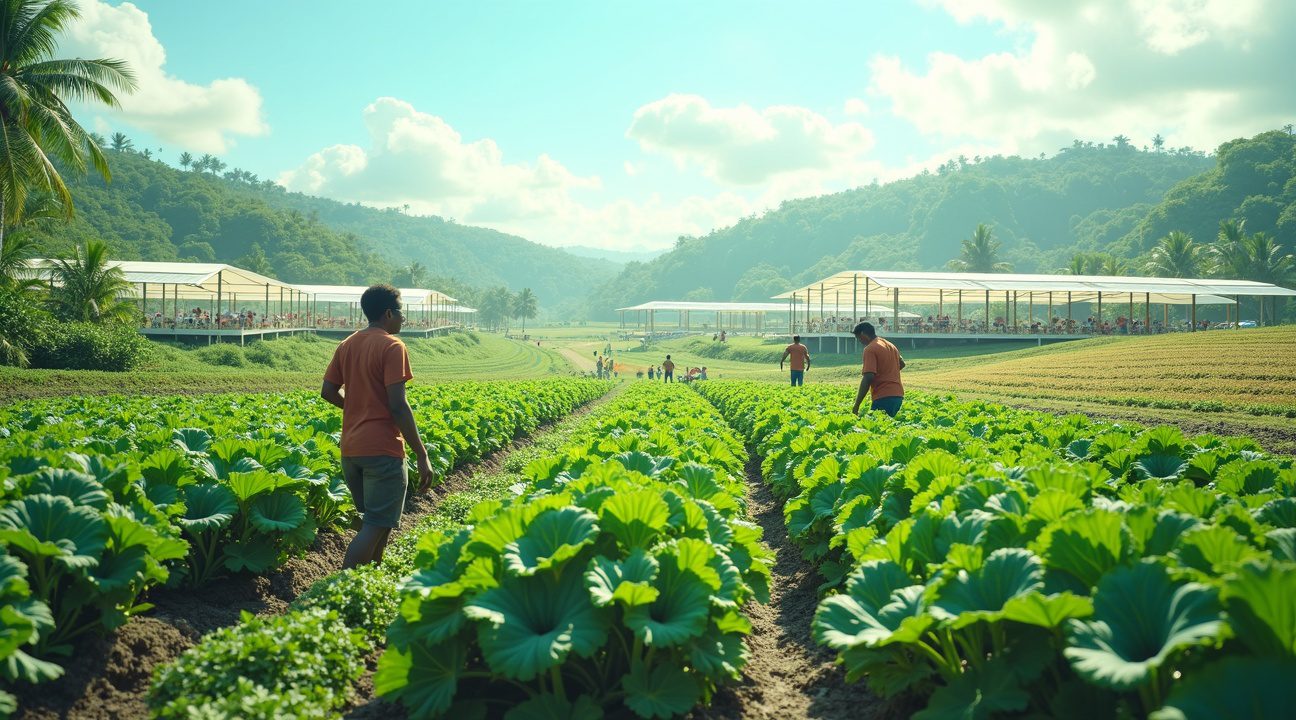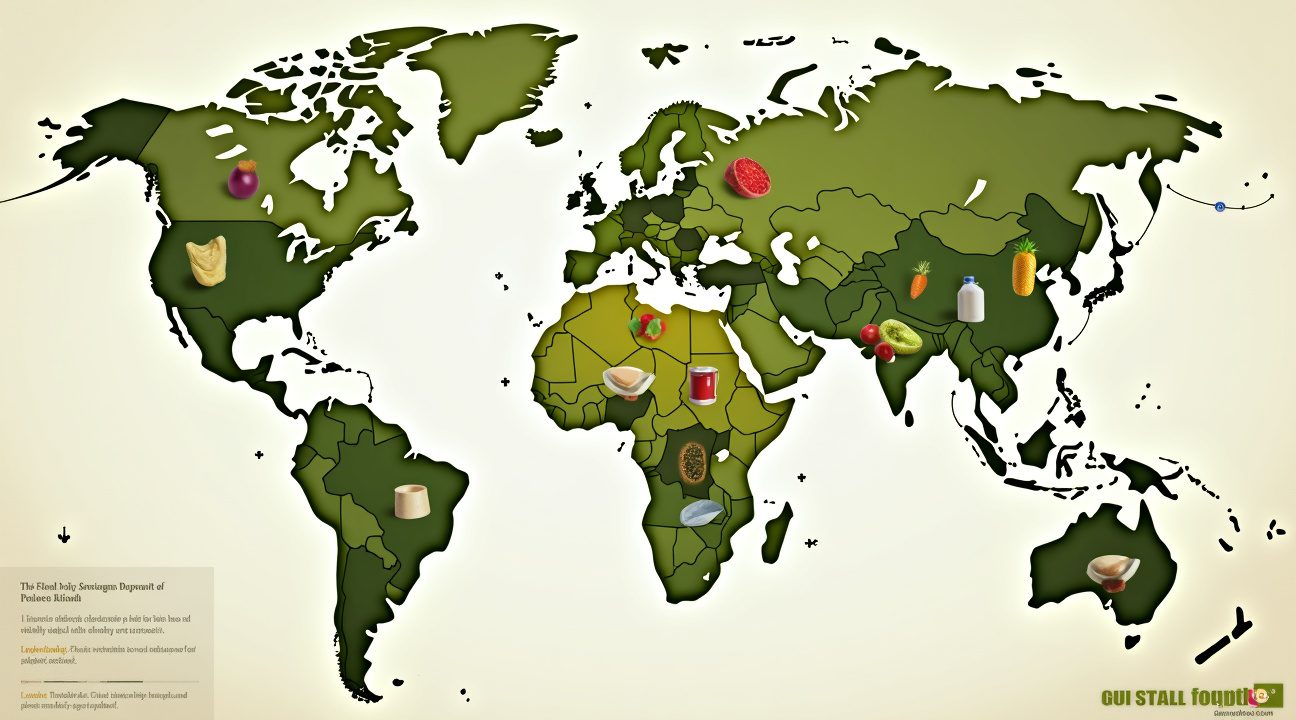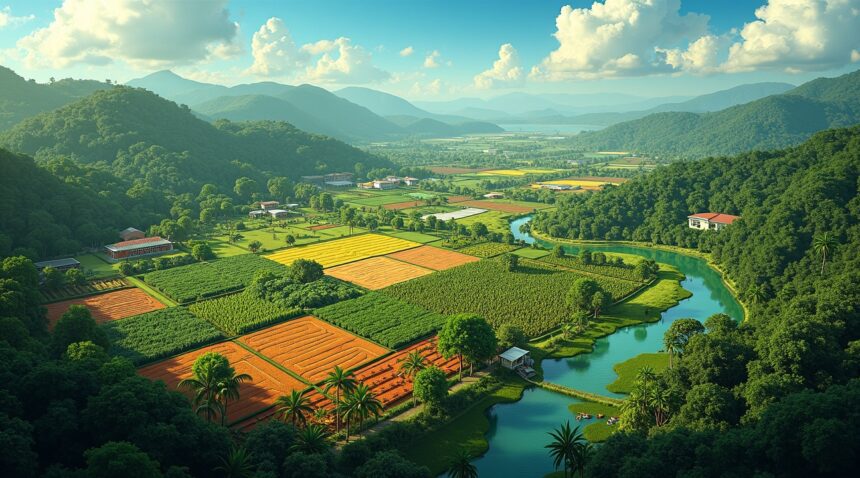Guyana has achieved a historic milestone unparalleled by any other country: complete food self-sufficiency in all seven major food groups.
Key Takeaways
- Guyana is the only nation in the world that domestically produces enough food across all seven major food groups—fruits, vegetables, dairy, fish, meat, plant-based proteins, and starchy staples—to fully meet the dietary needs of its population of approximately 800,000 people.
- The country’s geographic and environmental makeup plays a pivotal role in its success, with fertile coastal plains, varied climate zones, and plentiful freshwater sources supporting diverse agricultural production.
- Massive increases in government agricultural investment since 2020 have accelerated development. Between 2020 and 2025, spending has increased by 468%, including GY$430.9 million for the rice sector and GY$300 million for upgrading fisheries infrastructure.
- Compared to the global landscape, Guyana stands out dramatically. Only one out of every seven countries achieves food independence in five or more food groups, and agricultural giants like China and Vietnam continue to import dairy to meet demand.
- Guyana is emerging as the region’s agricultural leader. It is spearheading the CARICOM initiative ‘Vision 25 by 2025’, a program designed to reduce the Caribbean’s dependence on food imports and foster long-term regional food sovereignty.
The World’s Only Truly Food-Independent Nation: A Scientific Breakthrough
Guyana stands alone among all nations as the sole country capable of feeding its entire population without external food imports. According to research published in the scientific journal Nature Food, this South American nation achieved complete self-sufficiency across all food categories when researchers analyzed 186 countries worldwide.
Complete Nutritional Independence Across Seven Food Groups
Self-sufficiency in Guyana’s case means the country produces enough food within its borders to meet the nutritional needs of its entire population across all seven major food groups. These categories include:
- Fruits
- Vegetables
- Dairy
- Fish
- Meat
- Plant-based proteins
- Starchy staples
No other nation matches this comprehensive food production capability.
The achievement becomes even more remarkable when compared to other agricultural powerhouses. China and Vietnam, despite their massive agricultural sectors, only meet requirements for six out of the seven food groups. Both countries fall short in dairy production, with China achieving just 29% dairy self-sufficiency and Vietnam reaching only 14% in this category.
What Sets Guyana Apart
Several factors contribute to Guyana’s unique position in global food security. The country’s diverse climate zones support year-round agricultural production across multiple crop types. Abundant freshwater resources and fertile coastal plains provide ideal conditions for both crop cultivation and livestock farming.
Guyana’s relatively small population of approximately 800,000 people also plays a crucial role in achieving food independence. This demographic advantage allows the country’s agricultural output to exceed domestic consumption needs across all food categories. The nation’s extensive coastline supports a thriving fishing industry, while inland areas provide space for cattle ranching and crop diversification.
Regional specialization within Guyana ensures balanced food production. Coastal areas focus on:
- Rice cultivation
- Aquaculture
While interior regions support:
- Cattle farming
- Fruit production
This geographic distribution of agricultural activities maximizes the country’s natural advantages while minimizing food production gaps.
The research from Nature Food highlights how rare true food self-sufficiency has become in our interconnected global economy. Most countries rely on international trade to fill nutritional gaps, making Guyana’s achievement particularly significant for understanding sustainable food systems and national food security strategies.
How Guyana’s Agricultural Powerhouse Feeds Its People
Guyana’s ability to feed its entire population stems from its exceptional agricultural foundation built on fertile alluvial plains that stretch across the coastal regions. These nutrient-rich soils create ideal conditions for bumper harvests of rice and starchy root vegetables that form the backbone of the country’s food security strategy.
The country’s rice production stands as a testament to agricultural efficiency, with annual seed production reaching 152,000 bags through strategic government investment. I’ve observed how the 2025 government allocation of GY$430.9 million specifically designated for the rice sector demonstrates the nation’s commitment to maintaining food independence. This substantial funding ensures that rice paddies continue delivering consistent yields that exceed domestic consumption requirements.
Diversified Protein Sources Drive Self-Sufficiency
Riverine fisheries and extensive pastureland work together to provide abundant protein sources that satisfy all domestic dietary needs. The livestock sector receives significant support through initiatives like the Broiler Breeder Project, which has successfully produced 167,000 hatching eggs while assisting over 5,500 farmers in expanding their operations. These programs ensure that poultry production meets local demand while creating sustainable income streams for rural communities.
Fisheries development has accelerated through strategic infrastructure investments, including the expansion of the Satyadeow Sawh Aquaculture Station to 14 acres and GY$300 million in upgrades to fisheries landing sites. These improvements enhance both freshwater and marine fishing capabilities, guaranteeing that protein requirements remain fully satisfied through domestic production.
The government’s agricultural investment strategy has transformed since 2020, with public spending in agriculture increasing by approximately 468%. This dramatic funding increase strengthens sectoral resilience and supports continuous growth across all agricultural subsectors. Such investment levels demonstrate how strategic planning can achieve complete food self-sufficiency even in developing economies.
Guyana’s agricultural success creates a buffer that goes beyond basic sustenance, generating surplus production that could potentially support food exports. The combination of fertile soils, abundant water resources, favorable climate conditions, and strategic government investment has positioned this South American nation as a unique example of agricultural self-reliance in an increasingly interconnected global food system.
Why Most Countries Can’t Match Guyana’s Achievement
Only one in seven countries produce enough food to be self-sufficient in five or more food groups, making Guyana’s comprehensive food independence a remarkable global exception. I’ve analyzed global food production patterns, and the data reveals why most nations struggle to achieve what this South American country has accomplished.
Most countries excel in meat and dairy production, with 65% overproducing these protein sources relative to their domestic needs. However, this singular strength masks critical weaknesses in other essential food categories. Countries that dominate livestock production often lack the agricultural diversity needed for complete nutritional self-reliance.
Critical Gaps in Global Food Production
The most significant shortfalls occur in nutrient-dense plant foods and fish production. Fewer than half of all countries meet their local needs for plant-based protein sources, including beans, lentils, nuts, and seeds. Similarly, starchy carbohydrates present production challenges for many nations, despite being dietary staples.
Several factors contribute to these widespread deficiencies:
- Geographic limitations that restrict crop diversity
- Climate constraints that prevent year-round cultivation
- Economic policies favoring export crops over domestic food security
- Limited access to fishing waters or declining marine resources
- Insufficient investment in agricultural infrastructure
- Urban development reducing available farmland
Small island nations face particularly acute challenges, as limited land area restricts agricultural expansion. Much of Africa remains heavily reliant on food imports despite having vast agricultural potential, often due to infrastructure limitations and climate variability. Middle Eastern states contend with arid conditions that severely limit crop production, forcing dependence on imported grains and vegetables.
I find it telling that no economic union worldwide achieves full self-sufficiency across all food groups. Even large trading blocs like the European Union face persistent shortfalls in certain food types, despite pooling resources from multiple member countries. This reality underscores how exceptional Guyana’s achievement truly is.
The EU’s struggles highlight a crucial point about modern food systems. While economic integration allows countries to specialize in their most efficient crops, it doesn’t guarantee comprehensive food security. Member nations might excel in wheat production but lack sufficient protein crops or face seasonal gaps in fresh produce.
Trade dependencies create vulnerabilities that self-sufficient countries like Guyana avoid entirely. Supply chain disruptions, political tensions, or economic sanctions can quickly transform food import relationships into national security concerns. Countries relying on imports for basic nutrition face constant exposure to price volatility and availability risks.
Agricultural specialization, while economically logical, often comes at the expense of food security. Nations focusing on cash crops for export markets frequently neglect diverse food production for domestic consumption. This strategy maximizes short-term economic returns but creates long-term dependency on global food markets.
Climate change adds another layer of complexity to global food production. Extreme weather events, shifting precipitation patterns, and rising temperatures disrupt traditional agricultural zones. Countries dependent on specific climate conditions for their primary crops face increasing uncertainty about future production capacity.
Water scarcity further limits agricultural potential in many regions. Nations lacking adequate freshwater resources struggle to maintain diverse crop production, especially for water-intensive foods like rice or certain vegetables. Irrigation infrastructure requires significant investment that many developing countries can’t afford.
Population density also plays a crucial role in food self-sufficiency. Highly populated countries with limited agricultural land face mathematical challenges in feeding their citizens domestically. Urban expansion continues reducing farmland in many developed nations, making complete food independence increasingly difficult to achieve.
Guyana’s success stems from its unique combination of favorable factors: abundant land, diverse climate zones, sufficient water resources, and relatively small population. These advantages allow the country to maintain agricultural diversity while avoiding the trade-offs that force other nations into food import dependency.
Government Strategy: From Investment to Regional Leadership
Guyana’s government has transformed its agricultural sector through strategic investment and forward-thinking policies that position the country as a regional powerhouse. I’ve observed how this small South American nation has achieved remarkable results through targeted funding and innovative programs that extend far beyond its borders.
Unprecedented Investment Growth
The numbers tell a compelling story of commitment. Between 2020 and 2025, Guyana increased its sectoral allocations by an impressive 468%, demonstrating that agricultural development sits at the core of national priorities. This dramatic funding boost has enabled the country to modernize farming practices, expand production capacity, and establish itself as the Caribbean’s primary food supplier.
Guyana now serves as the ‘breadbasket’ of the Caribbean, a role that carries both opportunity and responsibility. The government has embraced this position by spearheading the CARICOM ‘Vision 25 by 2025‘ regional program, which targets a significant reduction in the Caribbean’s food import bill through expanded domestic agricultural production. This initiative represents more than economic strategy—it’s about creating food sovereignty for an entire region.
Youth-Centered Innovation Programs
The Agriculture Innovative and Entrepreneurship Programme (AIEP) exemplifies how strategic policy can reshape demographics and create lasting change. This program has successfully engaged young people in agricultural careers, with over 70% of participants transitioning into agribusiness ventures. The initiative addresses a critical challenge many countries face: attracting younger generations to farming and food production.
The program’s infrastructure development has been equally impressive. More than 200 shade houses have been constructed specifically for high-value crops including:
- Broccoli
- Cauliflower
- Carrots
These controlled-environment facilities allow farmers to produce premium vegetables year-round while protecting crops from extreme weather events and pests.
These policy initiatives create a comprehensive framework that addresses multiple challenges simultaneously:
- Climate resilience becomes achievable through diversified production systems and protected growing environments.
- Regional food security strengthens as Guyana’s expanded capacity reduces the Caribbean’s dependence on distant suppliers.
- Youth empowerment in agriculture ensures that knowledge and innovation continue flowing through generations of farmers and entrepreneurs.
The government’s strategy demonstrates how targeted investment can create ripple effects across multiple sectors and countries. By positioning agriculture as both an economic driver and a tool for regional leadership, Guyana has crafted policies that serve immediate needs while building long-term sustainability and influence throughout the Caribbean basin.

Breaking Down the Seven Food Groups That Define True Self-Sufficiency
Food security experts evaluate national self-sufficiency through seven critical food groups: fruits, vegetables, dairy, fish, meat, plant-based protein, and starchy staples. This comprehensive framework captures the full spectrum of nutrients humans need for optimal health and survival.
Guyana stands alone as the world’s only nation achieving complete sufficiency across all seven categories. Most countries struggle to meet domestic demand in at least one group, creating vulnerabilities in their food security infrastructure. The gaps typically emerge in vegetables, plant-based protein, or dairy production, where climate constraints or agricultural limitations prevent adequate local output.
European Countries Face Significant Shortfalls
European nations demonstrate these challenges clearly. Russia produces only 33% of its fruit requirements domestically, despite its vast agricultural lands. Latvia’s fruit production covers merely 13% of national consumption needs, while Estonia manages just 3% self-sufficiency in this category. These statistics reveal how even developed economies with established farming sectors can’t achieve complete food independence.
The vegetable sector presents similar obstacles for many nations. Countries with shorter growing seasons or limited arable land often import substantial portions of their fresh produce. Dairy production requires specific geographic and climatic conditions that don’t exist everywhere, forcing nations to rely on international suppliers.
Plant-based protein sources represent another common weakness. Legumes, nuts, and other protein-rich plants require specific soil conditions and climate patterns. Nations without these advantages must import significant quantities to meet population needs.
Starchy staples like grains and root vegetables form the foundation of most diets worldwide. Countries that can’t produce sufficient quantities of rice, wheat, potatoes, or other staple crops face immediate food security risks during supply chain disruptions.
Fish production depends heavily on coastal access and sustainable marine ecosystems. Landlocked countries naturally struggle with this category, while coastal nations may face overfishing or environmental challenges that limit their catch capacity.
Meat production requires extensive land use and specific agricultural infrastructure. Countries with limited grazing areas or environmental restrictions often can’t meet domestic protein demands through livestock alone.
Guyana’s unique position stems from its diverse climate zones, abundant freshwater resources, and varied agricultural landscapes. The country produces sufficient quantities across all seven groups, creating a buffer against global food price volatility and supply chain disruptions that affect most other nations.

Sources:
Caribbean News Global – “Guyana is the only nation among 186 that achieves full self-sufficiency in food production study finds.”
DPI (Department of Public Information, Guyana) – “Guyana is the only country that can fully feed itself – study finds”
The Caribbean Camera – “Guyana Achieves Global Food Self-Sufficiency Milestone”
BBC Science Focus – “Only one country in the world produces all the food it needs …”
Visual Capitalist – “The 50 Most Food Self-Sufficient Countries in the World”
ScienceAlert – “Just One Nation Produces Enough Food For Itself …”
Nature Food (2025), “Gap between national food production and food-based dietary requirements”


